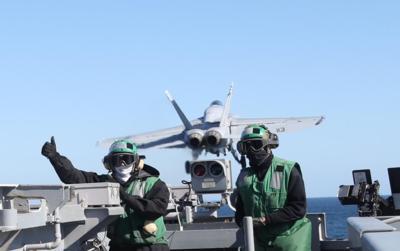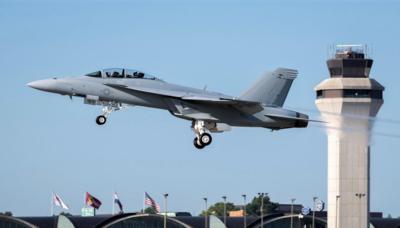Fri, Dec 17, 2021
Precision Landing Mode Automates, Simplifies High-Precision Flight in Refueling and Landing
The Navy's infamously difficult carrier landings, long the bane of Naval aviators in their early training days, have seen the first major equipment update in years, with flight control tech that leverages automation, connectivity, and precise aircraft control.

Precision Landing Mode (PLM) is the newest capability from the Navy's PMA-265 Program office, a system that, according to the announcement: "drastically reduces the number of inputs a pilot must make on final approach to the carrier. With its optimized control laws and tailored displays, PLM eases pilot workload and makes landing much safer and simpler. Additionally, it improves overall recovery time, reduces tanker requirements and streamlines training requirements."
The latest version of the upgrades were delivered to the fleet in October 2021, improving on previous iterations of the system that disabled the tech under many failure conditions. Now, PLM can be engaged during engine-out approaches, or even with a fire on board the aircraft. “During a single-engine approach, PLM helps to provide the pilot with a platform that feels very similar to a dual-engine approach, maximizing climb performance and helping the jet stay in balanced flight,” said Commander Luke Davis. “PLM provides the pilot with a reliable, stable platform to safely recover at the ship or airfield.”

The system is now baked into each pilot's training from the start, being included for new pilots of the F/A-18E/F Super Hornet or it's Growler sister aircraft. Air wings have added it to their carrier qualification deployments, noting that in some cases their training requirements have gone down by up to 50%. Old salts in the ready room may decry the timeless pattern of technology replacing hard-earned but worthwhile pilot skills once again, but like many other newfangled adjuncts, the romance of doing everything manually is seldom found during an engine out, hard IFR approach.
More News
Its Offerings Are Lighter, Cleaner, and Now Pushing Past 1,000nm on SAF Jet Fuel DeltaHawk’s diesel-powered aircraft lineup has seen incredible upgrades over the last few yea>[...]
The Airplane Experienced A Total Loss Of Engine Power On December 3, 2025, about 1600 central standard time, a Mooney Aircraft Corp. M20K, N57229, was substantially damaged when it>[...]
Make Sure You NEVER Miss A New Story From Aero-News Network Do you ever feel like you never see posts from a certain person or page on Facebook or Instagram? Here’s how you c>[...]
Aero Linx: European Society of Aerospace Medicine (ESAM) As a pan-European, independent forum, it works to promote the safety and health of all persons involved in aviation and spa>[...]
“We are excited to see Wisk achieve this milestone, and I’m so proud of the team that made it possible. The team at Wisk has built advanced technologies across flight c>[...]
 Aero-TV: DeltaHawks Diesel Power Steps Into the Spotlight
Aero-TV: DeltaHawks Diesel Power Steps Into the Spotlight NTSB Prelim: Mooney Aircraft Corp. M20K
NTSB Prelim: Mooney Aircraft Corp. M20K ANN FAQ: Turn On Post Notifications
ANN FAQ: Turn On Post Notifications ANN's Daily Aero-Linx (12.20.25)
ANN's Daily Aero-Linx (12.20.25) Aero-News: Quote of the Day (12.20.25)
Aero-News: Quote of the Day (12.20.25)




